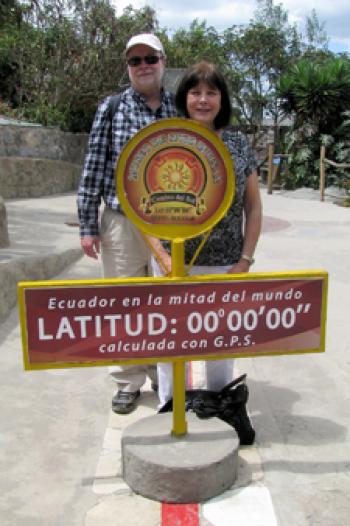Quito vs. Bogotá
This item appears on page 13 of the November 2016 issue.
When my wife, Paula Owens, and I spent several days in Bogotá, Colombia, in July 2015, our visit was not without hiccups, but we thoroughly enjoyed ourselves. [See “Procuring Cash in Colombia,” Oct. ’15, pg. 12, and “Advice for Visitors to Bogotá,” Nov. ’15, pg. 12.]
We expected a similarly pleasant experience for our July 2016 visit to Quito, Ecuador, especially since both capitals are located in the Andean highlands, with Quito being only 450 miles south of Bogotá and just south of the equator. The two cities experience similar weather, Quito having a slightly warmer climate.
Although it didn’t seem like it, Bogotá is the much larger of the two cities. On our visit to each, we stayed in the city’s historic Old Town and explored the area on foot.
Immediately upon our arrival in Quito’s Old Town, it became apparent that our assumptions didn’t match reality. The Old Town’s streets were clogged with traffic, the noise level was high, and it was dirtier than Bogotá. The first thing I saw when I stepped out of our taxi was a dead rat in the gutter (yikes!).
As we checked in to our hotel, we were provided with a copy of eight security tips from the National Police of Ecuador. Most of the tips were routine, but the fourth was particularly worrisome, since in Quito it gets dark by 7 p.m.: “If you go out in the night, remember to take a taxi for going and coming to the hotel.”
As we explored the Old Town, we noticed the presence of many police officers of various types. That had also been the case in Bogotá, but it felt so safe there that this level of protection seemed excessive. In Quito, we didn’t get those “safe” vibes and were glad of the extensive police presence.
Quito’s Old Town contains an assortment of plazas, old houses of worship and a few museums. While, collectively, the various churches, cathedrals and the basilica were more impressive than those found in Bogotá’s Old Town, none captivated me as much as had Bogotá’s Iglesia Museo de Santa Clara.
We also felt Quito’s Old Town museums didn’t measure up to those in Bogotá (or, for that matter, those in the much smaller Cuenca, Ecuador, which we had visited earlier on this trip). There were few English explanations for exhibits in Quito, which was a bit perplexing, since we encountered considerably more English-speaking inhabitants than we had found in Bogotá. There were also many more foreign tourists in Quito.
We noticed other differences of importance between these two cities. We were affected more by Quito’s high altitude (9,350 feet) than Bogotá’s only slightly lower elevation (8,675 feet). Perhaps that’s because Quito is much hillier; walking from the lower reaches of La Ronda to the Basilica del Voto Nacional was a significant workout.
You can drink the tap water safely in Bogotá but not in Quito.
On the other hand, Ecuador uses the US dollar for its currency, which is a huge convenience for American travelers.
Quito’s new and efficient airport is a big plus, but it’s located much farther from the city center (25 miles, or 35 to 60 minutes) than is Bogotá’s airport (9 to 10 miles, or 20 to 40 minutes). The extra distance is partially offset by a new highway link.
Quito also is building a long metro line, which should greatly enhance traveling within this sprawling city. Completion is scheduled for 2019.
Quito’s biggest advantage over Bogotá may be the numerous tempting day trips available from tour companies at reasonable prices. From Quito, it’s easy to day trip to Cotopaxi National Park, Otavalo, Cotacachi and more.
We took a couple of day trips and were very pleased with both. The first was to Cotopaxi National Park. The second took us to the Mitad del Mundo complex (where, before GPS, the equator was thought to be), the Museo Solar Intiñan (where GPS determined the equator is actually located) and up and down Pichincha on the TelefériQo, or cable car, and to other sights in Quito.
From Bogotá, the most appealing day trip is probably Zipaquirá, with its underground Salt Cathedral in a salt mine. However, after reading the description in Moon’s “Colombia” guide, our expectations were raised too high. It was fine, but it was gloomy and could have used more lighting.
Overall, we much preferred Bogotá’s Old Town to Quito’s. We enjoyed Bogotá’s ambiance and found its attractions to be more interesting.
We did have an unexpected trip highlight while in Quito, however. On our second night there, we were shaken by a pair of strong earthquakes (magnitude 5.9 and 6.3) 10 minutes apart. Fortunately, damage was minimal, and, apparently, there were no injuries.
STEPHEN O. ADDISON, Jr.
Charlotte, NC


